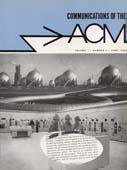Growing applications of linear programming
June 1964 - Vol. 7 No. 6

Features
Research and Advances An ACM state-of-the-art paper
Use of linear programming models has grown so extensively in recent years that the whole concept for organizing a computer code has undergone a radical change. It no longer is adequate merely to reduce a mathematical algorithm (i.e. the simplex method) to a computer code. An advanced code must cope with such a variety of situations that the respective computer subprograms must be organized into an integrated system.Emphasis in this paper is devoted to the underlying principles upon which future linear programming systems must be based. These viewpoints are influenced by the new demands that applications within the petroleum industry are placing on such systems. Some of the components of such a system are: translation of problem statement in terms of basic data to linear programming matrix coefficients, data transmission for direct computer entry, data file at the computer center, data processing and editing prior to solving the simplex algorithm, an efficient and reliable code for solving the above-mentioned algorithm, and flexible means for summarizing the results.
Research and Advances Programming languages
Symbol manipulation in FORTRAN: SASP I subroutines
A set of subroutines for use in FORTRAN are described whose purpose is to synthesize output strings from (i) input strings which have been analysed by the SHADOW general syntactic analysis subroutine reported earlier, and/or (ii) packed BCD strings formed in any way. Function-type subroutines are included for intermediate manipulations, which are performed on the strings which are stored in an abbreviated internal representation. The automatic way in which an internal representation for each newly created substring is stored sequentially in a block of common storage, and the manner in which a storage block is dynamically allocated for that purpose, are discussed.
Research and Advances Algorithms
Research and Advances Techniques
Design and implementation of a general-purpose input routine
A general-purpose input routine is discussed and advocated for FORTRAN. The philosophy of such programs is examined and exemplified.
Research and Advances Techniques
Reducing truncation errors by programming
In accumulating a sum such as in a numerical integration with a large number of intervals, the sum itself becomes much larger than the individual addends. This may produce a less accurate sum as the number of intervals is increased.Separate variables can be established as accumulators to hold partial sums within various distinct intervals. Thus, the extensive successive truncations are eliminated.
Research and Advances Techniques
The list concept as originally proposed by Newell, Simon and Shaw specified single computer words as elements of a list. This report describes the use of two or more consecutive words as one element. Such use results in a considerable saving in both the space required to hold a given amount of data, and in the execution time required to perform a given process on the data.Following a brief description of standard list structures with single-word items, the multiword items are introduced. Then variable-length items are described, along with the corresponding space-utilization problems. Finally, several examples are given to illustrate the use of multiword lists.This paper attempts to draw together various recent papers which have applied some of these concepts in different ways, and indicate how they relate to the more general problem.
Research and Advances Techniques
A parts breakdown technique using list structures
List structured parts breakdown is proposed and discussed. Implementation facts are presented on operating program using these techniques.
Research and Advances Numerical analysis
Numerical solution of nonlinear two-point boundary problems by finite difference methods
Solution of nonlinear two-point boundary-value problems is often an extremely difficult task. Quite apart from questions of reality and uniqueness, there is no established numerical technique for this problem. At present, shooting techniques are the easiest method of attacking these problems. When these fail, the more difficult method of finite differences can often be used to obtain a solution. This paper gives examples and discusses the finite difference method for nonlinear two-point boundary-value problems.
Research and Advances Numerical analysis
Approximate solution of axially symmetric problems
A variety of physical problems in such diverse fields as electrostatic field theory, heat and ideal fluid flow, and stress concentration theory reduce, under the assumption of axial symmetry, to the study of the elliptic partial differential equation ∂2u/∂x2 + ∂2u/∂y2 + k/y(∂u/∂y) = 0. Dirichlet-type problems associated with this equation are studied on regions whose boundaries include a nondegenerate portion of the x-axis and exceedingly accurate numerical methods are given for approximating solutions.
Research and Advances Numerical analysis
Generation of test matrices by similarity transformations
A method for obtaining test matrices with a prescribed distribution of characteristic roots is given. The process consists of using particularly simple similarity transformations to generate full matrices from canonical forms. The matrices generated also have known characteristic vectors, inverses and determinants.
Opinion Letters to the editor



